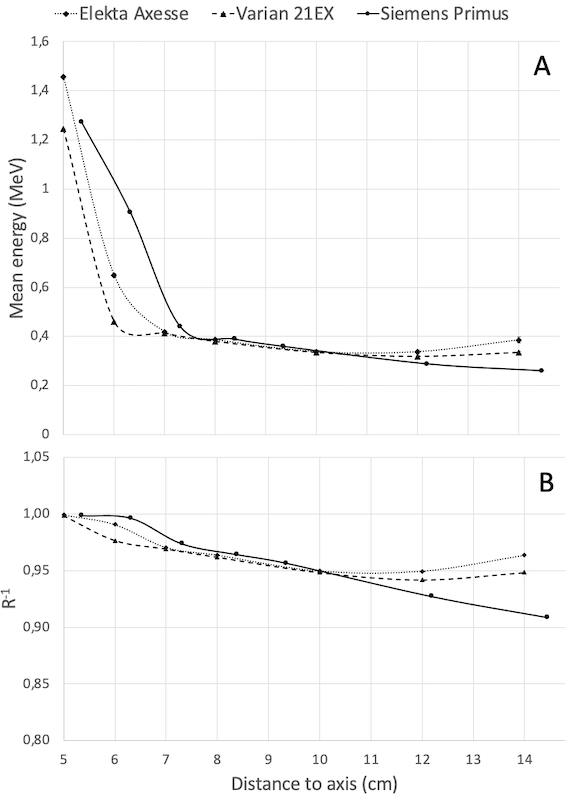Energy correction for TLD100 measurements up to 10 cm from the field edge for 3 different linacs
Beatriz Sanchez Nieto,
Chile
PO-1601
Abstract
Energy correction for TLD100 measurements up to 10 cm from the field edge for 3 different linacs
Authors: Beatriz Sanchez nieto1, Leticia Irazola Rosales2, Francisco Sánchez-Doblado3, Jose Luis Rodriguez-Mongua4, Edgardo Doerner5, Ignacio Espinoza5
1Pontificia Universidad Católica de Chile, Instituto de física, Santiago, Chile; 2Clínica Universidad de Navarra, Servicio de Radiofisica y protección radiológica, Pamplona, Spain; 3Universidad de Sevilla, Departamento de Fisiología Médica y Biofísica, Sevilla, Spain; 4Pontificia Universidad Católica de Chile, Instituto de Física, santiago, Chile; 5Pontificia Universidad Católica de Chile, Instituto de Física, Santiago, Chile
Show Affiliations
Hide Affiliations
Purpose or Objective
It
is well-known that if the TLD100 dosimeters are calibrated in a primary MV
beam, the TLD100 signal per delivered dose outside of the treatment field will
be greater than expected because of the dosimeter’s overresponse to the softer
spectrum outside the field (TG-158). Therefore, out-of-field photon dose
measurements with TLD-100 require the use of a correction to the calibration
factor that depends on the energy spectra at each measurement position. The majority
of second cancers appear within the first few centimeters from the field-edge,
and there is also interest in the dose at points close to the field (e.g., pace
markers during thoracic irradiation). Thus, this work concentrates on the first
10 cm from the field edge. We calculated energy correction factors using a
previously published model [1] for the Elekta Axesse (Agility MLC), Varian 21EX
(Millenium 120 MLC), and Siemens Primus (with Toshiba MLC), based on the mean
energy, calculated by MC simulations, as a function of isocenter distance.
Material and Methods
The BEAMnrc code, built on the EGSnrc system,
was used to create all three linacs models. Energy spectra were computed at
different positions outside 10x10 cm2 square fields using 6 MV
photon beams from which mean energies were calculated. The spectra were calculated
at 5 cm depth in water for Elekta (SSD = 95 cm) and Varian (SSD = 100 cm) [2]
and at 10 cm depth for Siemens (SSD = 100 cm) [3]. It is expected
that depth and SSDs differences at which simulations were performed do not
impact the mean energy dramatically [4].
Multiplicative energy correction to the
calibration factor for TLD100 measured under standard conditions were
calculated as 1/R, where R is given by the expression presented in [1] for the
following model parameters: α1=10,92 keV-1, E1=-4,32
keV, α2=3,5x106
keV3 and E2=-66,7 keV
Results
Simulated mean energies at different distances
from the field-edge are shown in figure 1A for the three cases (error bars are within
the symbol size). The corresponding energy correction factors (R-1)
are shown in figure 1B.

Figure
1: Mean energy and R-1 values as a
function of the distance to the axis for a 10x10 cm2 6MV photon field
Conclusion
As expected, at the border of the field, where
the mean energy is ̴1 MeV, there is no need for corrections to the
calibration factor (i.e., R-1=1). At 5 cm from the field edge, R-1
becomes 5% for the three linacs studied. At larger distances, the
correction becomes more linac-dependent. The largest correction (
̴ 9%) was found for the Siemens Primus at
about 10 cm from the border of the field.
References
1. Duggan
et al. Phys. Med. Biol. 49: 3831–3845, 2004 and corrigendum
2. Sanchez-Nieto
et al. Med. Phys. Med. Phys. 47 (9): 4616-4625, 2020
3. Irazola
et al. Applied Radiation and Isotopes 123: 32–35, 2017
4. Scarboro
et al. (Med. Phys.) 38 (5):2619-2628, 2011